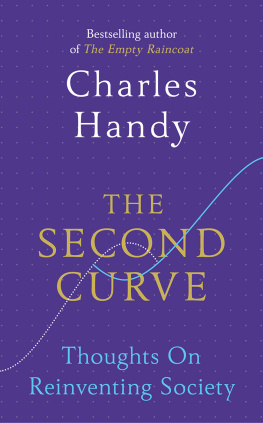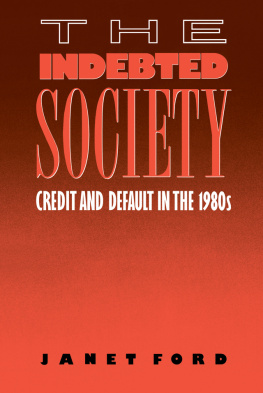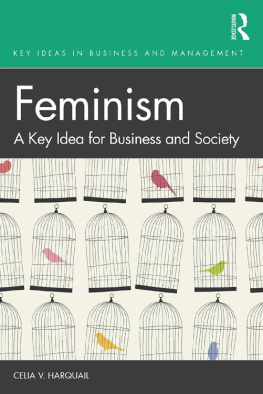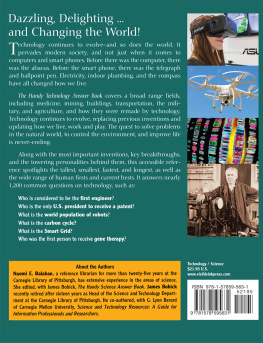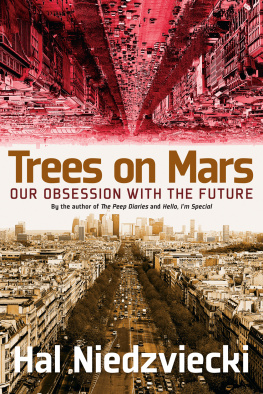CONTENTS
ACKNOWLEDGEMENTS
MANY PEOPLE, OFTEN unknowingly, have contributed to this book. It was Gail Rebuck, my long-time publisher, friend and adviser, who suggested that I might revisit some of my ideas from two decades back to see whether they still applied in todays circumstances. This tempted me not only to revisit those ideas but to spread my wings a bit wider and push the idea of the Second Curve into other areas of society beyond those of the organisation. Nigel Wilcockson, my editor at Random House, then helped to shape these ideas into a book. I am grateful to him for his patience and gentle persuasion as I struggled to find a way to structure my thoughts, while Rosalind Fergusson corrected my erring facts and my verbal infelicities with great tact.
Many are those who have influenced my thinking down the years. I am thinking of the now-departed great gurus of management, Warren Bennis (my old friend and mentor) and Peter Drucker. Jim OToole, Aristotelian interpreter, and Michael Maccoby, whose psychoanalytical and anthropological background provided new insights into leadership, have also been among my informal teachers down the years. Then there are all those scholars whose books fill my shelves and whose ideas have rubbed off on me down the years, in particular Tom Peters, Jim Collins, Lynda Gratton, Mark Goyder and John Kay, although they should not be held responsible for anything I have written here.
Richard Straub, founder of the Drucker Forum in Vienna, has been a constant source of support and inspiration, while journalists such as Simon Caulkin and Adrian Wooldridge have fed my head with their stimulating articles and ideas. Then there is Gordon Fox; Buddhist, philosopher, businessman and inspiring friend who has shown me how good principles can build great businesses. I am indebted to all these wise folk and to many others too numerous to list.
The book, however, would never have happened without my wife and partner, Elizabeth. Her unwavering belief in me has eclipsed my doubts, her good sense has restrained my wilder excesses, while her unfailing support and affection has underpinned my life.
ABOUT THE BOOK
Charles Handy is one of the giants of contemporary thought. His books on management including Understanding Organizations and Gods of Management have changed the way we view business. His work on broader issues and trends such as Beyond Certainty has changed the way we view society.
In The Second Curve, Handy builds on a lifes work to glimpse into the future and see what challenges and opportunities lie ahead. He looks at current trends in capitalism and asks whether it is a sustainable system. He explores the dangers of a society built on credit. He challenges the myth that remorseless growth is essential. He even asks whether we should rethink our roles in life as students, parents, workers and voters and what the aims of an ideal society of the future should be.
Provocative and thoughtful as ever, he sets out the questions we all need to ask ourselves and points us in the direction of some of the answers.
ABOUT THE AUTHOR
Charles Handy is an independent writer, broadcaster and teacher. He has been an oil executive, an economist, a professor at the London Business School, the Warden of St. Georges House in Windsor Castle and the chairman of the Royal Society for the Encouragement of Arts, Manufacture and Commerce. He was born in Co. Kildare in Ireland, the son of an archdeacon, and educated in Ireland, England (Oxford University) and the USA (Massachusetts Institute of Technology). His many books include The Empty Raincoat, Understanding Organizations, Gods of Management, The Future of Work and Waiting for the Mountain to Move. He and his wife Elizabeth live in London and Norfolk.
Also by Charles Handy
The New Philanthropists (with Elizabeth Handy)
Myself and Other More Important Matters
Reinvented Lives (with Elizabeth Handy)
The Elephant and the Flea
Thoughts for the Day (previously published as Waiting for the Mountain to Move)
The New Alchemists (with Elizabeth Handy)
The Hungry Spirit
Beyond Certainty
The Empty Raincoat
Inside Organizations
The Age of Unreason
Understanding Voluntary Organizations
Understanding Schools as Organizations
The Future of Work
Gods of Management
Understanding Organizations
1
THE SECOND CURVE
What is it? How do we find it?
THINKING ABOUT IT, I must have been a very irritating husband, in more ways than one, no doubt, but principally because I kept changing my job just when things were going well. After ten years with Shell I had reached the small country manager stage, the first step to greater things, when I decided that the life of an oil executive was not for me, that I would rather teach managers than be one. The old saying if you cant do it, teach it probably applied, if I am honest. To Shells surprise, and even perhaps disappointment, I turned down the posting and resigned.
After two years of readjusting and retraining I joined the London Business School: six years later I reached the exalted rank of a full professor with my first book published and the holy grail of tenure (guaranteed employment until retirement) granted, only to decide that it was not what I wanted to spend my life doing. That was to be a full-time writer. It took four years in one more job to build up the courage to cut that umbilical cord that ties one to the womb of an organisation. Only then did I feel that I had come into my own. Just in time, too, or I would have ended up in Davys Bar.
I have often, down the years, told my story of the road to Davys Bar, and its imagery, along with its implications, still haunts me. This is the story as it happened then, for Davys Bar is no longer there: I was driving through the Wicklow Mountains, the bare but beautiful hills outside Dublin, when I lost my way. I saw a man walking his dog so I stopped beside him and asked if he could point me on the way to Avoca, where I was heading. Surely, he said, and its dead easy. You go straight ahead up this hill then down again for a mile or so until you get to a stream with a bridge over it; on the other side of it youll see Davys Bar; you cant miss it, it is very bright red. Have you got that now? I think so, I said. Straight up, then down, until I come to Davys Bar. Great; well, half a mile before you get there, turn right up the hill and that will take you to Avoca.
I had thanked him and driven off before I realised the strange Irish logic of his directions. But its message stuck with me until I started talking about the challenge of the Second Curve, that turn to the right up the hill which you will often have passed without knowing it was where you should have gone. I have met too many organisations (and, indeed, individuals) parked in the equivalent of Davys Bar, having realised, too late, that they have missed the turn to the future and can only look back regretfully and drown their sadness with a mournful drink or two, while they reminisce about the good times and what might have been.
Unwittingly, in my career, I was riding a sequence of roads up the hill, having turned each time before I got to the equivalent of Davys Bar. When I drew the curves out, my up-and-down trajectory began to make sense. Since then the curves have influenced much of my thinking about change and, more generally, the future. The idea of the sigmoid curves, as they are properly called, is a metaphor. Metaphors are a great aid to understanding, not to be dismissed because they are not strictly scientific. They are low-definition concepts, imprecise in detail but unexpectedly revealing in the way we look at things. There will be many more of them in this book.
Next page
